



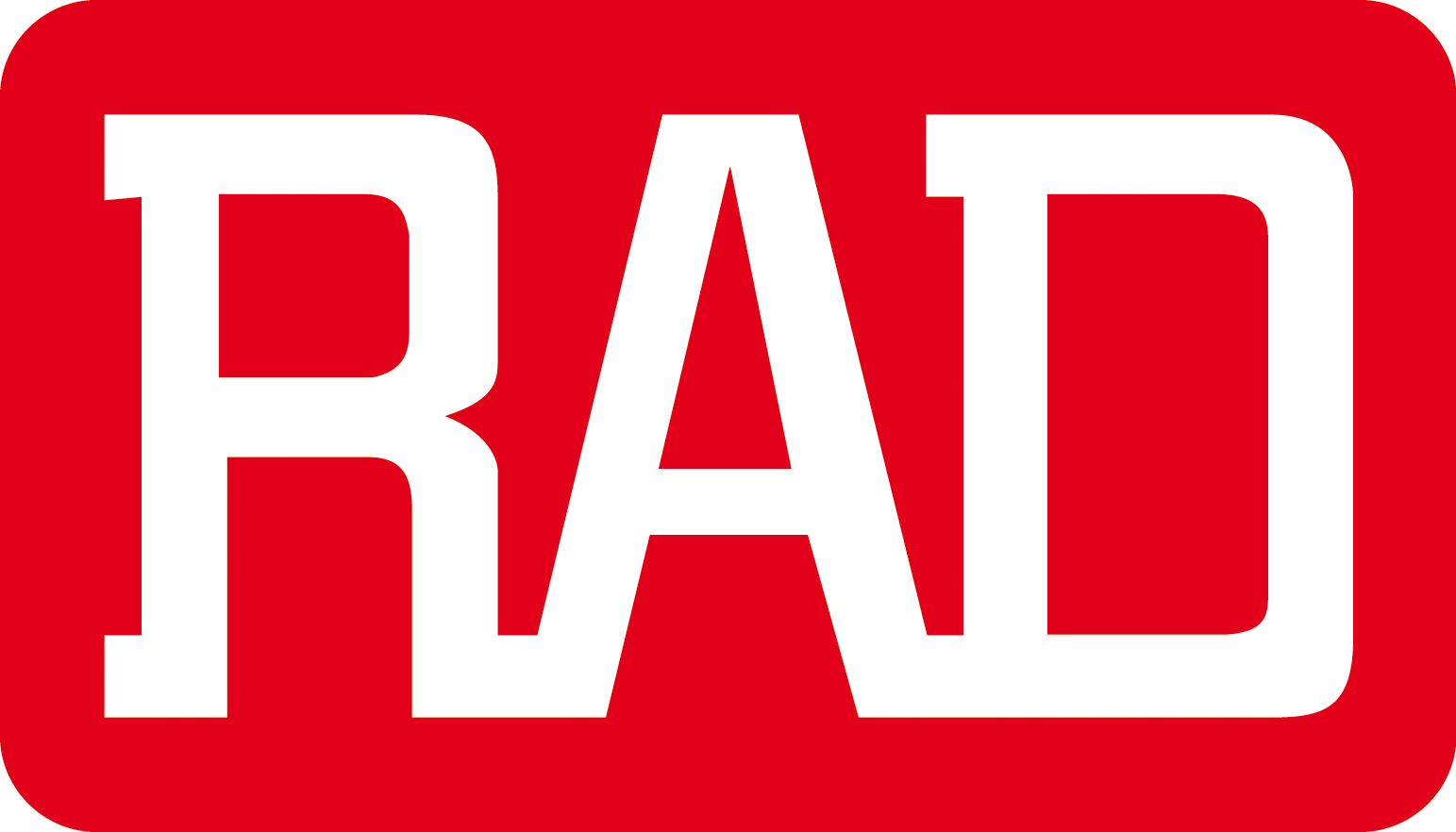
Megaplex -2100
Megaplex-2100 and Megaplex 2104 are modular integrated access TDM multiplexers, which
integrate multiple dedicated data, voice, ISDN and LAN channels over multiple main
(network) links. RAD Megaplex equipped with 8-port main link modules in conjunction
with the 12-port high-speed module features a traffic payload capacity of up to 248 DS0 timeslots. The modules of
version 11 and lower support up to 124 DS0 timeslots (8 Mbps).
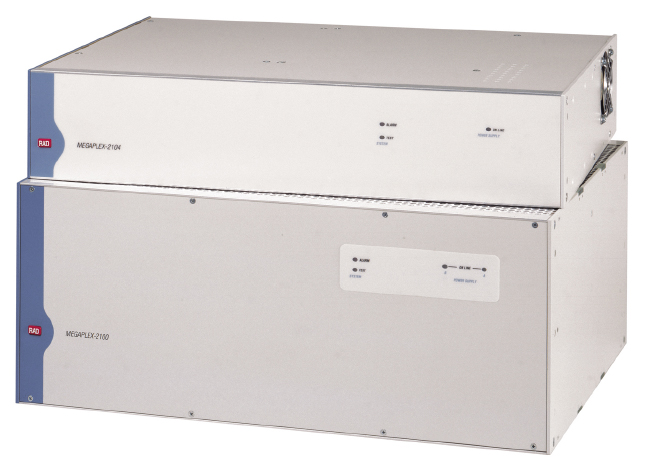
The flexible, modular RAD Megaplex with a wide choice of I/O (user interface) modules was
designed for applications ranging from railroads, power utilities, police and fire
departments, small campus networks to multi-site corporate networks or extensive carrier
access solutions. Due to Megaplex’s standards adherence, central office based cross-connect units (DACS) can separate
voice and data, sending each to the appropriate carrier or service.
Megaplex enables carriers to successfully deploy bundled services, ISDN services and
Internet access. The integration of a broad
range of services makes the RAD Megaplex a cost-effective access device, with reduced
deployment and maintenance costs. Megaplex with TDMoIP technology provides a cost-effective, versatile and
modular solution for transmitting legacy TDM traffic over IP networks. This is especially suitable for large corporations,
utilities or power companies that are seeking a gradual migration to IP networks.
The equipment conforms to international standards, ensuring compatibility in multi-vendor environments worldwide.
TDMoIP with the RAD Megaplex
Megaplex offers an optional IP main link module
( MP-2100M-ML-IP/UTP/1E ) that transmits TDM traffic directly
over IP networks. This TDMoIP access module converts user TDM traffic into IP packets transmitted on 10/100BaseT or
100BaseF Ethernet
networks thus helping to protect your equipment investment. T1 today, IP
tomorrow just by changing the mainlink module.
Megaplex Chassis ( MP-2100 and MP-2104 )
The chassis is available in two basic variants:
Megaplex-2100 (4U high) chassis providing slots for up to 12 main link and I/O modules
Megaplex-2104 (2U high) chassis providing slots for up to 5 main link and I/O modules.
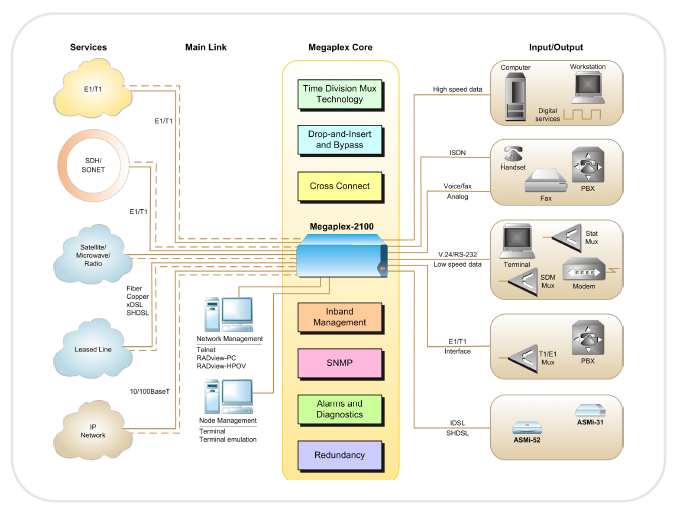
RAD ( MP-2100 and MP-2104 ) Megaplex timing options
Multiple system timing options are available:
Internal crystal oscillator clock
Clock received from any link (loopback)
Clock from any high speed module channel
External station (master) clock
Adaptive timing received from any bundle (with ML-IP only).
Any clock source can be set as fallback in the event of primary clock source failure.
Megaplex ( MP-2100 and MP-2104 ) redundancy
Megaplex’s modular, distributed architecture enables redundancy at different levels of the network and
provides a system with no single point of failure.
System hardware redundancy is attained by an optional redundant power supply and common logic module (MP-2100
chassis only).
1:1 protection switching on the main link modules protects against network or cable
failure. Additional ML modules can be installed and interconnected via Y-cables to provide protection against ML hardware
failures.
Bundle redundancy provides backup for IP transmissions (functions similarly to
E1 / T1 link “parallel TX” redundancy).
In case of link failure, Megaplex activates alternate routing. This is achieved by
storing multiple configuration databases and flipping (switching) between them in
case of any network event.
This can be very important to railroads, power and gas utilities as well as air traffic
control and more.
The RAD Megaplex ( MP-2100 and MP-2104 ) system also supports two RAD proprietary types of ring redundancy,
provided by its main link modules:
E1 / T1 Ring: Similar to SDH, the E1/T1 ring features ring redundancy in a
closed dual-ring topology: one path propagates data “clockwise” and the other “counterclockwise”. Each
Megaplex can receive data through two different paths, and selects only the signal received through one of the
paths for processing. In case of failure, the failed segment is bypassed by using the second path, providing
self-healing in less than five seconds.
RFER: The TDMoIP link module features RAD’s Resilient Fast Ethernet Ring
(RFER) technology for creating self-healing Ethernet ring networks. RFER reroutes traffic within 50 msec of
a ring segment failure, providing fast redundancy performance similar to SDH networks.
Survivability is further enhanced by RFER’s scalable support for multiple rings. RFER can carry up to
40 E1 or 50 T1 links with no limit on the number of nodes.
The built-in, non-blocking, DS0 cross-connect matrix enables routing any channel’s timeslots to any link. This allows
Megaplex to maximize its efficiency by splitting voice and data channels and redirecting the traffic, via separate links,
to the appropriate service.
The cross-connect matrix also enables routing timeslots from any link to any other link. This facilitates drop insert,
bypass or broadcast multi-link applications.
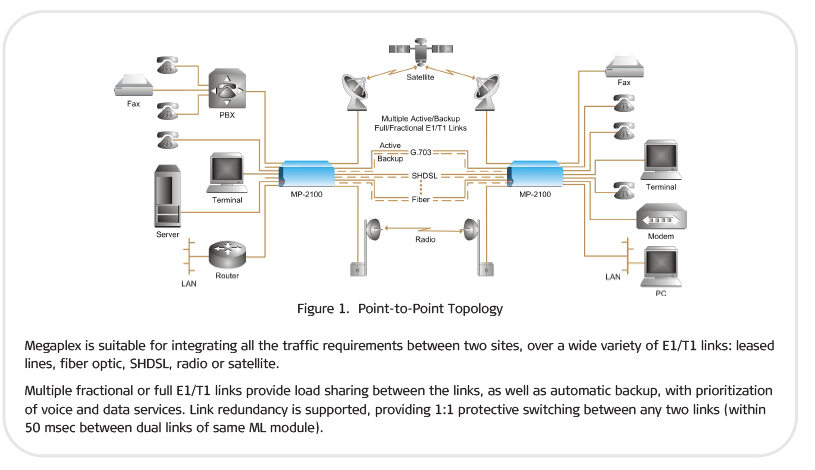
A total of 124 timeslots can be allocated, either for transmission of I/O channels or
for bypassing timeslots between links of different modules.
R2 Signaling Supported with the Megaplex Mainlinks
Main Link (ML) modules support R2 signaling with transparent MFC/DECADIC, so that Megaplex can be placed between
an older R2-PBX and a digital (E1-CAS) PBX. The MFC/DECADIC signaling is not terminated by Megaplex, but passed on to
the PBX. In addition to the ITU-T standard R2 protocol, several predefined national
PTT protocols, as well as user-defined variations, are also supported. Since the
R2 signaling support is provided by the ML, all voice module types support R2.
Megaplex ( MP-2100 and MP-2104 ) Common Logic Modules
The Common Logic (CL) module controls the Megaplex operation and is the interface for its configuration and
management. It stores the application software and up to 10 configuration databases (depending on complexity) for
multiple independent configurations. The CL also stores all system event information. Flash EPROM for software
download is provided.
Two dedicated ports are provided on the CL module for management purposes. One port has a 9-pin DCE interface for direct
connection of a management terminal or PC. The other is ordered with one of the following interface options:
• Ethernet 10BaseT (UTP)
• Ethernet 10Base2 (BNC)
• V.24/RS-232 DTE.
An input voltage detector, intended for sensing external events (coming from temperature alarm sensors etc), generates
internal alarms, which are sent to the NMS station and reported to the user. Two outbound relays can be assigned to
be triggered by any user-selected major or minor alarm, for routing of Megaplex alarms to outside indicators, such as
buzzers and bells.
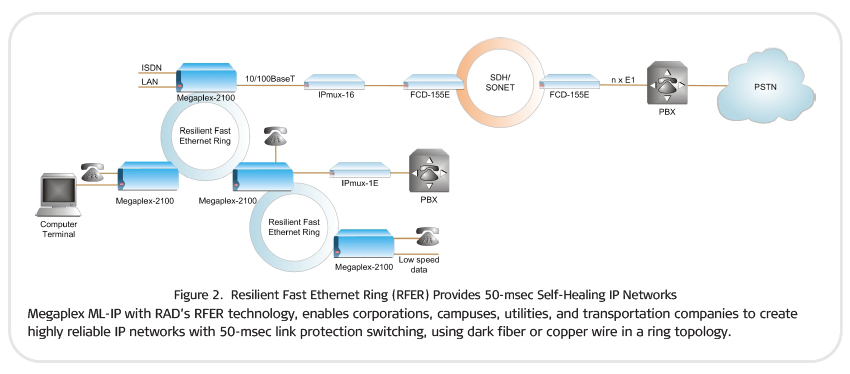
MAIN LINK MODULES OF THE RAD MEGAPLEX
Megaplex TDM E1 / T1 main link modules allow direct connection to a wide range of
services, eliminating the need for external equipment. Multiple active links can
operate in each chassis. Additional modules can also be installed for link redundancy.
The various ML modules can be configured for a broad range of applications: from
single link non-redundant operation, to multiple full or fractional E1 / T1 link
applications requiring drop & insert and broadcast.
E1 / T1 link modules with built-in fiber optic modems (range up to 100 km/62 miles) or
E1 link modules with xDSL modems (range up to 10.6 km/6.6 miles) are available. These special links reduce the cost of local
loop solutions by lowering equipment deployment and maintenance costs.
The dual-trunk main link modules increase efficiency and provide 1:1 protective switching between the two links within
50 msec.
The high-density 8-port E1, T1 and SHDSL modules increase the Megaplex TDM capacity up to 16 Mbps.
Megaplex
The unique ML-IP main link module converts the TDM bit stream delivered over the internal Megaplex back plane into
IP packets, for transmission over IP networks. ML-IP features three Ethernet ports, with 10/100BaseT or 100BaseF
interfaces. The module conforms to IEEE 802.3 and 802.3u and provides reliable, high quality of service (QoS), including
VLAN tagging and priority labeling (ToS). ML-IP places TDM imeslots into IP bundles
with VLAN tagging required by point-to-multipoint applications. Duplicate bundles can be transmitted simultaneously
on different paths for redundancy.
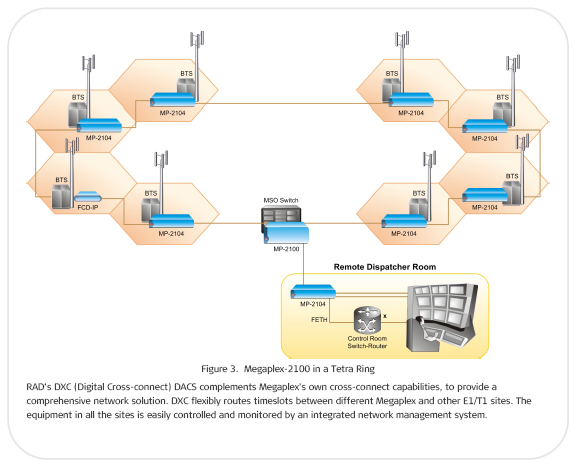
RAD MEGAPLEX ( MP-2100 and MP-2104 ) I/O MODULES
Up to 11 I/O modules of any kind can be placed in an MP-2100 chassis (up to 4 I/O
modules in an MP-2104). If more I/O modules are required, Megaplex 2100 and 2104
units can be cascaded.
High-Speed Data Modules
Megaplex ( MP-2100 and MP-2104 ) High speed data interface modules provide leased line data services,
operating at multiples of 56 or 64 kbps, up to 2.048 Mbps, connecting routers, bridges, front-end processors, etc.
E1 interface modules with built-in xDSL modems enable cost-effective long-range deployment of high speed services over
2- or 4-wire copper lines. Range is up to 4.0 km.
ISDN BRI (“U” or “S”) modules extend ISDN services over non-ISDN facilities,
supporting data, voice and Ethernet applications. The “U” interface modules employ IDSL technology for “last mile”
applications.
An IEEE C37.94-compliant n x 64 fiber data module is provided for transporting teleprotection data.
Low Speed Data Modules of the RAD Megaplex, MP-2100 and MP-2104
Sub-rate multiplexer modules for low speed (2.4 to 19.2 kbps) synchronous and asynchronous data channels employ
standard X.50, X.58 or SDM (DS0-B) multiplexing techniques.
Low-speed modules with sync/async V.24/RS-232 channels, with independent channel rates of up to 64 kbps are
available. End-to-end control signals are supported.
Megaplex Voice/Fax and Voice Compression Modules
Voice/fax modules transmit voice at toll quality using standard PCM (ITU-T G.711),
as well as ADPCM (G.726), MPMLQ (G.723.1), or P-CELP 4.8 kbps compression. Standard analog interfaces are available for
direct connection to POTS, public payphones, LB (local battery) field phones, PBX extensions or 2/4-wire E&M trunks.
Alternatively, voice compression modules with E1 and T1 digital PBX interfaces are
available. Loop, wink and ground-start signaling are also supported.
Digital voice compression modules connect PBX trunks with greater bandwidth utilization (compression ratio
of up to 10:1). The modules employ a choice of high quality voice compression
methods, including G.723.1 at 6.4 kbpsper channel, or G.729A at 8 kbps. The modules support Group
III fax and modem relay, at user-selectable standard rates of up to 14.4 kbps, featuring transparent
timeslot transfer, voice activity detection,
silence suppression, and comfort noise generation. Module versions are offered with single/dual T1 (up to 24/48
channels), or single/dual E1 (up to 30/60 channels) interfaces.
A special ”omnibus“ module provides four toll-quality voice channels to support
applications (see Figure 4) where a master site needs to communicate with multiple
remote stations simultaneously (such as to broadcast an important message).
VC-16 module
LAN Modules of the RAD Megaplex
Ethernet router/bridge modules enable LAN to LAN extension over E1/T1 services, offering various L2 capabilities.
RAD Megaplex, MP-2100 and MP-2104
MANAGEMENT
Megaplex can be fully configured locally, using an ASCII terminal. It can also be
managed remotely via Telnet, SNMP element management applications, or end-to-end path management application.
Megaplex communicates with the management station by means of its SNMP agent (via a SLIP/PPP or TCP/IP
connection). Network management applications provide centralized control of all network nodes, including interface
configuration, connection setup, alarms and monitoring.

The user-friendly GUI-based RADview network management applications facilitate management of both individual
units and entire networks.
The RADview-SC/TDM application enables end-to-end path management of MAP devices, providing physical and logical
graphic views of all network links and service paths of the system.
The management connection can be established by the following methods:
• Out-of-band, using the Ethernet management port. This simple and efficient method takes
advantage of IP bandwidth on demand, while saving link bandwidth for user traffic
• Inband over a dedicated timeslot, supporting standard PPP, FR encapsulation, and RIP2 protocols
• Over a modem link or over a FRAD, via the control port of the remote unit.

DIAGNOSTICS
Megaplex incorporates test features for rapid fault detection and easy maintenance. Upon power-up, all
system and modules perform self-test. Any
problems are reported to the management system. Loopbacks, BERTs and tone injections can be run on
individual channels or main links, towards both the network and user side.
The signaling monitoring capability useful for voice application diagnostics enables
RAD Megaplex to display a “snapshot“ of the current ABCD signaling bit states of any
selected timeslot that carries voice traffic.
All alarms, including state and frequency of occurrence, are stored in CL’s alarm
status buffer. Last 256 alarms are kept in a separate alarm history buffer.
Alarm status can be automatically read online by the management system from any node. User-set alarm masking,
filtering and inversion, as well as 5-level prioritization are also supported.
NEBS-COMPLIANT EQUIPMENT
Megaplex-2100 is also offered in a special NEBS-compliant version which meets the
Type-3 and Type-4 requirements, and permits reliable operation in harsher environmental conditions.
Contact your RAD distributor for more information on NEBS-compliant equipment.
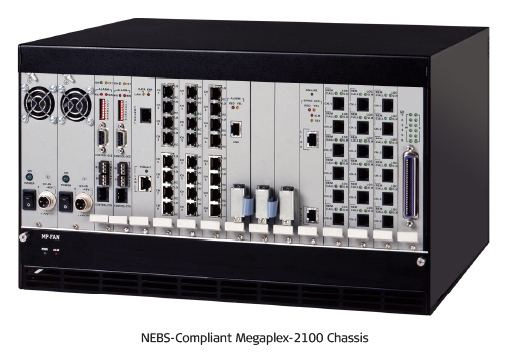
Megaplex-2100 and Megaplex-2104 product
data sheet (pdf)